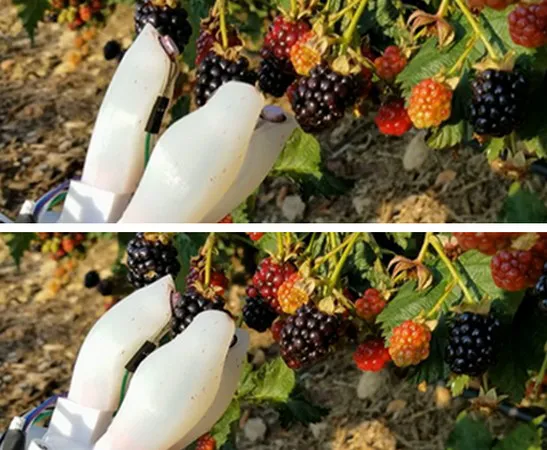Harvesting a field full of fragile blackberries is no easy task. Each of those juicy berries sold in the grocery store produce aisle has to be collected by hand because the fruit can be easily bruised or ruined altogether. Here in the South, the harvesting window happens right in the midst of the hot summer months. Plus, all of the berries on a single bush won’t necessarily be ripe for the picking at the same time, so it may take multiple pickings to gather all the fruit.
Biomedical engineering roboticist Yue Chen is working with collaborators at Georgia Tech and the University of Arkansas on an autonomous robotic solution to this backbreaking work. And though it’s a tool that seems far from the traditional purview of biomedical engineering, the system could lead to innovations in minimally invasive surgery one day.
“Harvesting is an excellent entry point to validate this kind of soft robotics technology in real-world applications,” said Chen, assistant professor in the Wallace H. Coulter Department of Biomedical Engineering at Georgia Tech and Emory University.
“I’m a medical-device person; I’m trying to develop a device that’s very dexterous, that’s very compliant, to save patients’ lives. I deal with a lot of math, engineering, and mechanics problems, and from that perspective, taking berries from a plant is quite similar to removing a tumor from the body,” he said. “You want to identify a target, perform the path planning, reach the target, remove the target very gently, and, most importantly, avoid damaging the surrounding tissue, like a blood vessel or a nerve.”
The researchers’ first advance is a soft robotic gripper that can gently grasp and remove blackberries from the plant — damage-free. They’re presenting the device this week at what’s billed as the largest robotics research gathering in the world, the IEEE International Conference on Robotics and Automation.
The prototype gripper resembles a bulbous three-fingered hand, which is no accident. Working with experienced blackberry researcher Renee Threlfall at the University of Arkansas, the team built a sensor glove and collected data about the force required to harvest berries and pickers’ typical technique.
“First, we characterized how much force the hand is generating, how many fingers we use to grasp the berries — we actually don’t use all five fingers, we use three fingers to grasp, and we characterized all of that,” Chen said.
With the force data and the three-fingers insight, Chen and the team set about designing. They used the human hand for inspiration, ultimately using soft silicone and embedded force sensors for the “fingers” and a unique tendon system for movement.
For more information:
Joshua Stewart
Wallace H. Coulter
Department of Biomedical Engineering
[email protected]

